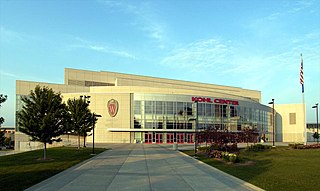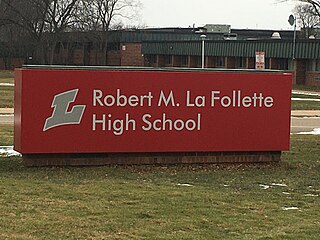
The Kohl Center is a multi-purpose arena located at the University of Wisconsin–Madison, United States. The arena opened in 1998 and is the home of the university's men's basketball and ice hockey teams, and the women's basketball team.

Marquette University High School (MUHS) is a private, all-male, Jesuit, Roman Catholic school located in Milwaukee, Wisconsin. It is accredited by the North Central Association Commission on Accreditation and School Improvement, an accreditation division of Cognia, and is a member of both the National Catholic Educational Association and the Jesuit Schools Network.

Vel Phillips Memorial High School is a public high school on the west side of Madison, Wisconsin, United States. It was built in 1966 and is part of the Madison Metropolitan School District.

Aquinas High School is a Roman Catholic high school located in La Crosse, Wisconsin. The school is part of La Crosse Aquinas Catholic Schools and is operated by the Diocese of La Crosse.

Arrowhead High School is a high school located in Merton Town, Wisconsin. Sitting on 117 acres (0.47 km2) of land, the school has two campuses, a north campus and a south campus. Juniors and seniors attend the north campus, while freshmen and sophomores attend the south campus.
Muskego High School is a comprehensive secondary school located in Muskego, Wisconsin. The school, administered by the Muskego-Norway School District, lies in southeast Waukesha County, in southeast Wisconsin. The district stretches through the city of Muskego and nearby Norway in Racine County.

Madison East High School is one of four comprehensive four-year high schools in Madison, Wisconsin. It was established in 1922, making it the oldest public high school still operating in Madison. The school mascot is "Peppy Purgolder", an animal resembling a feline. Madison East athletes compete in the WIAA Big Eight Conference. Its girls' swim team won the WIAA Division 1 state championship in 2007.
Ice hockey is a popular sport in the state of Wisconsin. Ninety high schools field sanctioned varsity teams competing in the Wisconsin Hockey Prep (WiHP) leagues of the Wisconsin Interscholastic Athletic Association (WIAA). Eight "club" non-sanctioned Wisconsin High School Hockey teams compete in the Wisconsin Amateur Hockey Association.

Appleton North High School is a comprehensive secondary school in Appleton, Wisconsin that is part of the Appleton Area School District. Opened in August 1995, it is the most recently built of the three four-year public high schools in the district. The school has 1,780 students. The school colors are gold, silver and navy blue. The school's nickname is the Lightning.

Edgewood High School of the Sacred Heart is a private, Catholic, college preparatory school located in Madison, Wisconsin. Edgewood has been sponsored since its inception by the Dominican Sisters of Sinsinawa, Wisconsin. In the 2019–2020 school year, it enrolled 476 students. Also on the Edgewood campus are Edgewood College and Edgewood Campus School, an elementary and middle school.
Germantown High School is a high school in Germantown, Wisconsin. It is part of the Germantown School District. The school was founded in 1957 as Washington Union High School.

Robert M. La Follette High School is a public high school located in Madison, Wisconsin, serving the city's far east side with its attendance boundaries including parts of the City of Madison, City of Fitchburg, Town of Blooming Grove, and Town of Burke, teaching students in grades 9-12. Founded in the fall of 1963, it is a part of the Madison Metropolitan School District, and is named after former lawmaker and 1924 presidential candidate Robert M. La Follette, Sr.
Marion Junior/Senior High School is a high school in Marion, Wisconsin, that serves students in grades 7 through 12. It has an enrollment of approximately 200 students. The school colors are blue and gold and the mascot is a Mustang.
The Milwaukee City Conference is a high school athletic conference in Milwaukee, Wisconsin. All full-time member institutions are located in the city of Milwaukee and are members of the Milwaukee Public Schools system. Its members participate in WIAA Division 1.
Belmont High School is a public high school located in Belmont, Wisconsin that serves students in grades 9 through 12. The school had an enrollment of 130 students in the 2006-2007 school year in a building that houses K-12. High school students attend classes in a new addition built in 2001, with classes for the K-8 students held in the older section. A gymnasium was also included in the new addition.
The Coulee Conference is a seven-member high school athletic conference in the La Crosse, Wisconsin area. It is affiliated with the Wisconsin Interscholastic Athletic Association. Conference schools have enrollments ranging from 236 to 540, with an average enrollment of 395.
Omro High School is a public high school in Omro, Wisconsin.

The Mississippi Valley Conference (MVC) is a high school athletic conference in southwest Wisconsin. All MVC schools are members of the Wisconsin Interscholastic Athletic Association (WIAA), and are located in the La Crosse, Wisconsin metropolitan area.
River Falls High School is a public high school in River Falls, Wisconsin.
Kewaskum High School is located in Kewaskum, Wisconsin, United States and is the lone high school in the Kewaskum School District. Kewaskum High School's instruction includes grades 9-12. As of the 2021-2022 school year, the student population is 579. The high school offers 12 Advance Placement courses as well as numerous courses that offer technical college credits.










